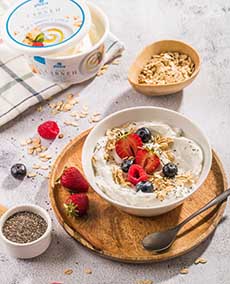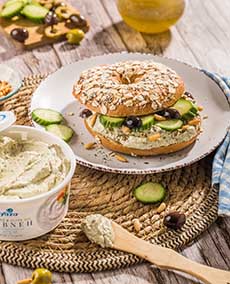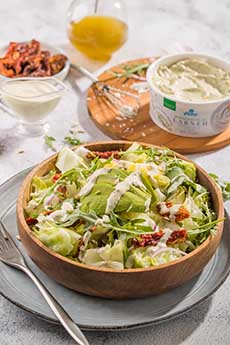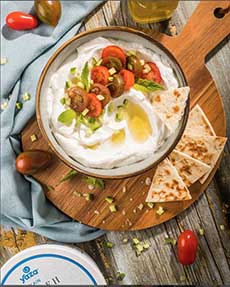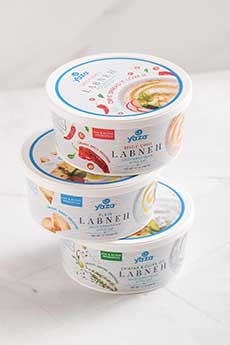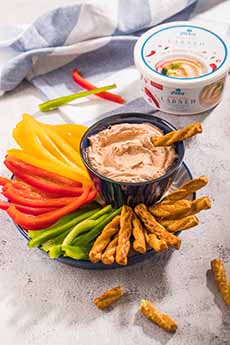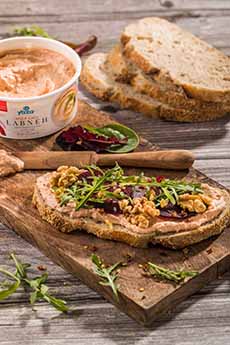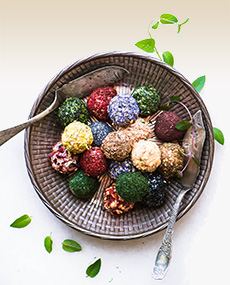Yaza Labneh: A Thick, Delicious Lebanese Spread & Dip
|
|
The Lebanese dip and spread labneh is made by straining Greek yogurt, an already strained yogurt, removing even more liquid. It’s doubly strained yogurt and a thick, creamy base for a spread or dip. It’s almost like a softer cream cheese, without the carrageenan or carob bean gum used to enable the block to be sliced. In the U.S. it is sometimes referred to as as a “yogurt cheese.” While there are fresh cheeses that look like labneh (fromage frais* is the best example), here’s the difference between yogurt and cheese: Alternate spellings are labaneh, lebnah, labne, or labni, among other spellings. The word is transliterated from Arabic. Laban is the Arabic word for yogurt. Pronunciation differs, too (see the footnote‡). > The different types of yogurt: a glossary. > The history of labneh is below. > So is a recipe to make labneh at home from Greek yogurt. Our Top Pick Of The Week is Yaza Labneh, a new brand. It’s made in the Catskills with cow’s milk from New York State dairy farms. And, it’s made in three wonderful flavors: Plain, Spicy Chili, and Za’atar & Olive Oil. The latter two are currently the only flavored labneh brands in the U.S. You’ll see za’atar mentioned several times in this article. It’s a staple spice blend of the Middle East, combining sesame seeds (often toasted) and sumac, with dried herbs such as oregano or marjoram and thyme, plus toasted spices like coriander and cumin. Here’s more about it. All three flavors are great on bagels, toast, or as dips. Yaza† labneh is simply delightful and has become a major part of our dairy consumption. The brand plans to be a staple in every American home. Traditionally, labneh has been sold in ethnic/specialty stores but it is currently sold in 17 states** with the aim to be in every state. As of this writing, Yaza is sold in 17 states: CO, CT, FL, GA, IL, IN, LA, MD, MI, NC, NJ, NY, OH, PA, TN, VA, and WI. The brand is currently in discussion with upscale and mass retailers nationwide. > Here’s a store locator. There are two types of labneh, Lebanese labneh and Turkish labneh. They are very different. Labneh is tangier and creamier than yogurt, and it’s meant to be eaten with savory ingredients. That hasn’t stopped American cooks from turning it into cheesecake, desserts with berries, flan, and even whipped cream. But let’s start with classic uses in Lebanon and other Middle Eastern countries: The exact origin of yogurt is uncertain, but it is thought to have appeared in Mesopotamia around 5000 B.C.E. Cheeses made from strained yogurt have been eaten for thousands of years in the Levant (a large area in the Eastern Mediterranean region of West Asia that comprises modern-day Israel, Jordan, Lebanon, Palestine, Syria, and a small part of southern Turkey—see image #9, below). Nomadic Bedouin tribes, who inhabited the Syrian Desert since at least 6000 B.C.E., used labneh as an important source of protein and even had a dry version to carry while traveling (think of modern yogurt powder, that can be reconstituted with water). The Armenians are widely credited with introducing labneh throughout much of the Middle East many centuries ago. The popularity of labneh grew quickly and before long every culture throughout the Middle East and beyond had developed its own unique version. The main differences between varieties are: Labneh is extremely easy to make, and in Lebanon, almost every family has their own special family recipe and technique. They typically make it from homemade raw milk yogurt, but you can use store-bought Greek yogurt. 1. SPRINKLE Greek yogurt with a bit of salt. 2. LINE a colander with cheesecloth, set it over a large bowl, and add the yogurt. Allow it to strain in the refrigerator or a cool room for 24 hours. That’s it! Your labneh is ready to eat and will keep, in a tightly covered container, for up to two weeks in the fridge. But you can also customize the flavor: 3. MIX IN your favorite herbs, such as fresh or dried chiles, chives, dill, garlic, or parsley. We also like to add sliced scallions or blend in a bit of tomato paste. Finally, can also form it into balls and preserve it in olive oil, where it will keep for months. Here’s how. |
|
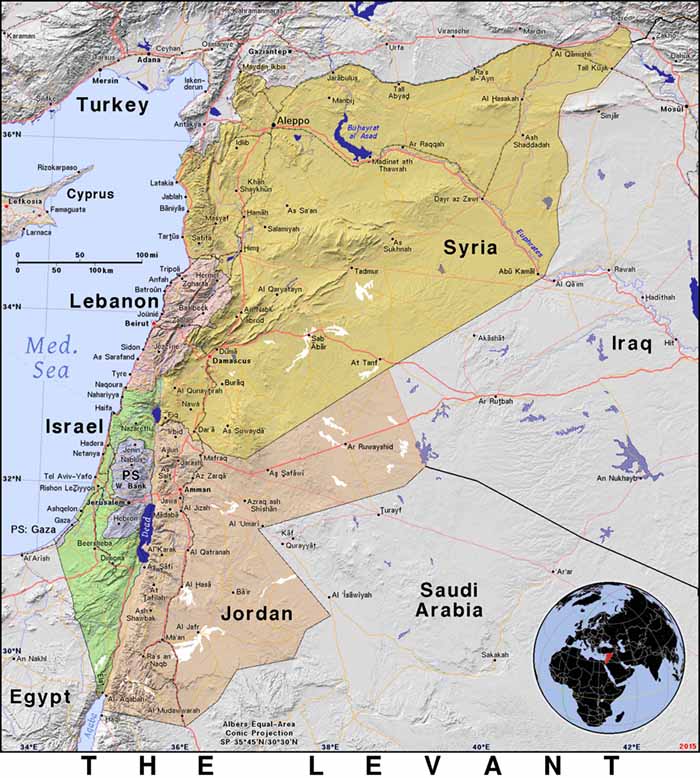 [9] The Levant (image via PAT, Public Domain). ________________ *Fromage frais is a light, fresh cheese that originated in France. It looks like Greek yogurt, but it’s technically a cheese. It has a mild, slightly tangy flavor and a smooth, creamy texture. It is often used as a spread or dip, although it can also be used in recipes to substitute for cottage cheese, mascarpone, ricotta, or sour cream. Frûche (pronounced froosh) is another fresh French cheese that has a mild flavor and a smooth, creamy texture. It’s like fromage frais but has a slightly higher fat content and thus is richer. **In the Northeast, check Balducci’s, Caraluzzi’s Markets, D’Agostino, Gristedes, King’s Food Markets, Morton Williams, Union Market, and other independent retailers and specialty stores across the nation. †The brand name, Yaza, is a mashup of taza, meaning fresh in Arabic; meza, the Arabic term for small plates/appetizers; and yogurt, as labneh is strained yogurt. The swirl in our logo mimics how labneh is traditionally presented in a bowl or plate as a dip. Clever! ‡The pronunciation differs per country. In Lebanon, it is pronounced LAB-NEH. You may hear LAB-NAH, LOB-NEH, LEB-NAY or other pronunciations across various countries and regions. CHECK OUT WHAT’S HAPPENING ON OUR HOME PAGE, THENIBBLE.COM. |
||
